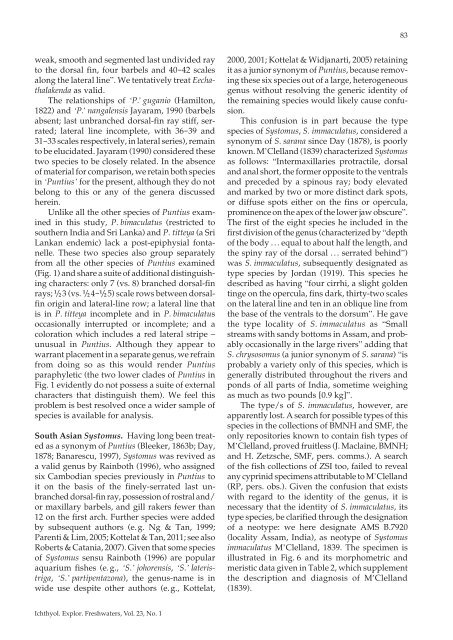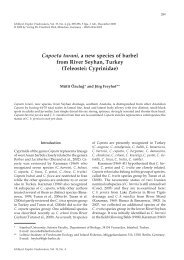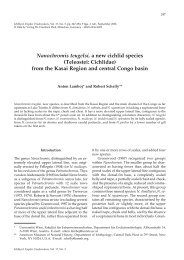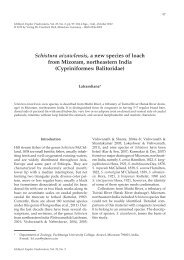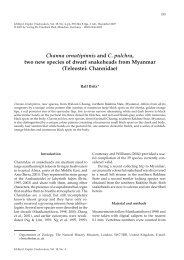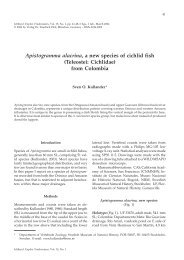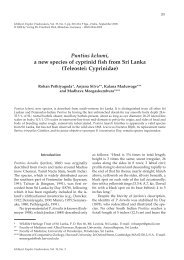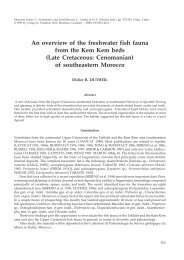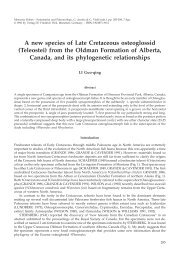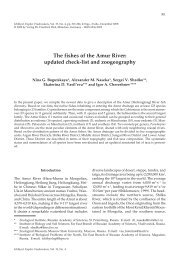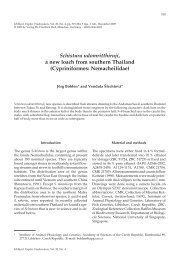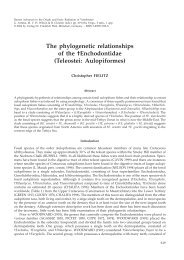A synopsis of the South Asian fishes referred to Puntius - Verlag Dr ...
A synopsis of the South Asian fishes referred to Puntius - Verlag Dr ...
A synopsis of the South Asian fishes referred to Puntius - Verlag Dr ...
Create successful ePaper yourself
Turn your PDF publications into a flip-book with our unique Google optimized e-Paper software.
weak, smooth and segmented last undivided ray<br />
<strong>to</strong> <strong>the</strong> dorsal fin, four barbels and 40-42 scales<br />
along <strong>the</strong> lateral line”. We tentatively treat Eechathalakenda<br />
as valid.<br />
The relationships <strong>of</strong> ‘P.’ guganio (Hamil<strong>to</strong>n,<br />
1822) and ‘P.’ nangalensis Jayaram, 1990 (barbels<br />
absent; last unbranched dorsal-fin ray stiff, serrated;<br />
lateral line incomplete, with 36-39 and<br />
31-33 scales respectively, in lateral series), remain<br />
<strong>to</strong> be elucidated. Jayaram (1990) considered <strong>the</strong>se<br />
two species <strong>to</strong> be closely related. In <strong>the</strong> absence<br />
<strong>of</strong> material for comparison, we retain both species<br />
in ‘<strong>Puntius</strong>’ for <strong>the</strong> present, although <strong>the</strong>y do not<br />
belong <strong>to</strong> this or any <strong>of</strong> <strong>the</strong> genera discussed<br />
herein.<br />
Unlike all <strong>the</strong> o<strong>the</strong>r species <strong>of</strong> <strong>Puntius</strong> examined<br />
in this study, P. bimaculatus (restricted <strong>to</strong><br />
sou<strong>the</strong>rn India and Sri Lanka) and P. titteya (a Sri<br />
Lankan endemic) lack a post-epiphysial fontanelle.<br />
These two species also group separately<br />
from all <strong>the</strong> o<strong>the</strong>r species <strong>of</strong> <strong>Puntius</strong> examined<br />
(Fig. 1) and share a suite <strong>of</strong> additional distinguishing<br />
characters: only 7 (vs. 8) branched dorsal-fin<br />
rays; 1 /2 3 (vs. 1 /2 4- 1 /2 5) scale rows between dorsalfin<br />
origin and lateral-line row; a lateral line that<br />
is in P. titteya incomplete and in P. bimaculatus<br />
occasionally interrupted or incomplete; and a<br />
coloration which includes a red lateral stripe –<br />
unusual in <strong>Puntius</strong>. Although <strong>the</strong>y appear <strong>to</strong><br />
warrant placement in a separate genus, we refrain<br />
from doing so as this would render <strong>Puntius</strong><br />
paraphyletic (<strong>the</strong> two lower clades <strong>of</strong> <strong>Puntius</strong> in<br />
Fig. 1 evidently do not possess a suite <strong>of</strong> external<br />
characters that distinguish <strong>the</strong>m). We feel this<br />
problem is best resolved once a wider sample <strong>of</strong><br />
species is available for analysis.<br />
<strong>South</strong> <strong>Asian</strong> Sys<strong>to</strong>mus. Having long been treated<br />
as a synonym <strong>of</strong> <strong>Puntius</strong> (Bleeker, 1863b; Day,<br />
1878; Banarescu, 1997), Sys<strong>to</strong>mus was revived as<br />
a valid genus by Rainboth (1996), who assigned<br />
six Cambodian species previously in <strong>Puntius</strong> <strong>to</strong><br />
it on <strong>the</strong> basis <strong>of</strong> <strong>the</strong> finely-serrated last unbranched<br />
dorsal-fin ray, possession <strong>of</strong> rostral and/<br />
or maxillary barbels, and gill rakers fewer than<br />
12 on <strong>the</strong> first arch. Fur<strong>the</strong>r species were added<br />
by subsequent authors (e. g. Ng & Tan, 1999;<br />
Parenti & Lim, 2005; Kottelat & Tan, 2011; see also<br />
Roberts & Catania, 2007). Given that some species<br />
<strong>of</strong> Sys<strong>to</strong>mus sensu Rainboth (1996) are popular<br />
aquarium <strong>fishes</strong> (e. g., ‘S.’ johorensis, ‘S.’ lateristriga,<br />
‘S.’ partipentazona), <strong>the</strong> genus-name is in<br />
wide use despite o<strong>the</strong>r authors (e. g., Kottelat,<br />
Ichthyol. Explor. Freshwaters, Vol. 23, No. 1<br />
83<br />
2000, 2001; Kottelat & Widjanarti, 2005) retaining<br />
it as a junior synonym <strong>of</strong> <strong>Puntius</strong>, because removing<br />
<strong>the</strong>se six species out <strong>of</strong> a large, hetero geneous<br />
genus without resolving <strong>the</strong> generic identity <strong>of</strong><br />
<strong>the</strong> remaining species would likely cause confusion.<br />
This confusion is in part because <strong>the</strong> type<br />
species <strong>of</strong> Sys<strong>to</strong>mus, S. immaculatus, considered a<br />
synonym <strong>of</strong> S. sarana since Day (1878), is poorly<br />
known. M’Clelland (1839) characterized Sys<strong>to</strong>mus<br />
as follows: “Intermaxillaries protractile, dorsal<br />
and anal short, <strong>the</strong> former opposite <strong>to</strong> <strong>the</strong> ventrals<br />
and preceded by a spinous ray; body elevated<br />
and marked by two or more distinct dark spots,<br />
or diffuse spots ei<strong>the</strong>r on <strong>the</strong> fins or opercula,<br />
prominence on <strong>the</strong> apex <strong>of</strong> <strong>the</strong> lower jaw obscure”.<br />
The first <strong>of</strong> <strong>the</strong> eight species he included in <strong>the</strong><br />
first division <strong>of</strong> <strong>the</strong> genus (characterized by “depth<br />
<strong>of</strong> <strong>the</strong> body . . . equal <strong>to</strong> about half <strong>the</strong> length, and<br />
<strong>the</strong> spiny ray <strong>of</strong> <strong>the</strong> dorsal . . . serrated behind”)<br />
was S. immaculatus, subsequently designated as<br />
type species by Jordan (1919). This species he<br />
described as having “four cirrhi, a slight golden<br />
tinge on <strong>the</strong> opercula, fins dark, thirty-two scales<br />
on <strong>the</strong> lateral line and ten in an oblique line from<br />
<strong>the</strong> base <strong>of</strong> <strong>the</strong> ventrals <strong>to</strong> <strong>the</strong> dorsum”. He gave<br />
<strong>the</strong> type locality <strong>of</strong> S. immaculatus as “Small<br />
streams with sandy bot<strong>to</strong>ms in Assam, and probably<br />
occasionally in <strong>the</strong> large rivers” adding that<br />
S. chrysosomus (a junior synonym <strong>of</strong> S. sarana) “is<br />
probably a variety only <strong>of</strong> this species, which is<br />
generally distributed throughout <strong>the</strong> rivers and<br />
ponds <strong>of</strong> all parts <strong>of</strong> India, sometime weighing<br />
as much as two pounds [0.9 kg]”.<br />
The type/s <strong>of</strong> S. immaculatus, however, are<br />
apparently lost. A search for possible types <strong>of</strong> this<br />
species in <strong>the</strong> collections <strong>of</strong> BMNH and SMF, <strong>the</strong><br />
only reposi<strong>to</strong>ries known <strong>to</strong> contain fish types <strong>of</strong><br />
M’Clelland, proved fruitless (J. Maclaine, BMNH;<br />
and H. Zetzsche, SMF, pers. comms.). A search<br />
<strong>of</strong> <strong>the</strong> fish collections <strong>of</strong> ZSI <strong>to</strong>o, failed <strong>to</strong> reveal<br />
any cyprinid specimens attributable <strong>to</strong> M’Clelland<br />
(RP, pers. obs.). Given <strong>the</strong> confusion that exists<br />
with regard <strong>to</strong> <strong>the</strong> identity <strong>of</strong> <strong>the</strong> genus, it is<br />
necessary that <strong>the</strong> identity <strong>of</strong> S. immaculatus, its<br />
type species, be clarified through <strong>the</strong> designation<br />
<strong>of</strong> a neotype: we here designate AMS B.7920<br />
(locality Assam, India), as neotype <strong>of</strong> Sys<strong>to</strong>mus<br />
immaculatus M’Clelland, 1839. The specimen is<br />
illustrated in Fig. 6 and its morphometric and<br />
meristic data given in Table 2, which supplement<br />
<strong>the</strong> description and diagnosis <strong>of</strong> M’Clelland<br />
(1839).


